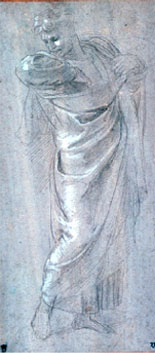
 Raphael. Saint Paul Rending His Garments, about 1483-1520, metal point heightened with white bodycolor on pale violet-gray prepared paper. Royal Collection ©2000 Her Majesty Queen Elizabeth II |
His intention to map out their design on paper is recorded in a number of connected sheets, among which is his magnificent study Saint Paul Rending His Garments, rendered with self-assurance and ecstatic energy. Such drawings were crucial in directing his assistants in the production of the cartoons. Only with the final and decisive corrections in the master's hand, however, were they deemed fit to be sent to Flanders for weaving. The production of wall paintings involved a similar collaborative enterprise. Raphael carefully administered each phase, from the initial composition studies to the making of cartoons for transfer of the design to the wall. Toward the end of his career, he encouraged his assistants to become his collaborators. This is most evident in the decoration of the garden loggia of Agostino Chigi's Roman villa, now known as the Villa Farnesina. Here, though Raphael was in charge of the underlying concept, his more mature followers participated in the creative aspect, and hence in the making of drawings, and were almost entirely responsible for the painting of the frescoes. |
||||||